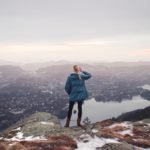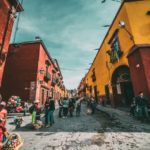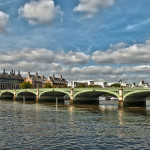Safety at Sea and Cocktails on the Catamarans with Dr. Margery Franklin

All physicians are required to have a certain number of hours of CME (continuing medical education) annually, to keep up to date with the rapidly changing field of medicine. Each state sets their own requirements, and many hospitals also demand proof of hours spent in study to qualify them to be on the medical staff.
I had been on the Pediatric Faculty of the University of Chicago and gave lectures, so after a while I grew tired of attending lectures on common subjects presented in pediatric workshops and conferences. I saw an ad in a medical journal for a CME on “Safety at Sea’ which peeked my interest since I am a sailor. How interesting to consider “Emergencies at Sea” – treatment for jellyfish stings, anaphylaxis or a heart attack while off-shore, “the Bends,” a well-known problem for scuba divers caused by rapidly changing pressure resulting in nitrogen bubbles in the blood stream.
I contacted the organizer of the workshop, who agreed to my attending the 2 hour didactic sessions held on a different island every morning, and the hour and a half question and answer sessions over cocktails on the catamarans in the evening, thus qualifying for the CME. I would be allowed to arrange my own charter of a monohull and sail it on the same course in the British Virgin Islands as the others, who would live aboard two catamarans.
My daughter came from Austin, Texas, to be the skipper, since she has her yacht master’s certification. A sailing buddy who navigated aircraft carriers around the Pacific came from Indiana to be our navigator, and my sister from Scotland and I, both with Captain’s licenses, were competent crew. We had a blast, provisioning in Tortola before setting off and eating most of our meals on the boat, a 38 foot Beneteau with 3 cabins and a grill which attached to the railing on the stern.
“Safety at Sea” started with a welcome cocktail party aboard one of the 2 catamarans moored in the lovely marina in Road Town, Tortola, in the British Virgin Islands.
“Safety at Sea” started with a welcome cocktail party aboard one of the 2 catamarans moored in the lovely marina in Road Town, Tortola, in the British Virgin Islands. We were given the schedule, and told which anchorages we should use to access the daily lectures on land from 8 – 10am. We also introduced ourselves to the other participants, healthcare providers with or without spouses, some of whom were sailors and some who had never sailed before. They could help to crew on the catamarans if they chose, as each had a professional captain.
I would leave my crew sleeping at 7.30 am., taking the dinghy to shore on whichever island we had arrived at the previous night, attend the 2 hour class, and return to find the others had breakfast, made the beds and done any clearing/cleaning so our boat was shipshape and ready to start our day’s sail as soon as I returned. Since we were all sailors, we took turns at the helm and crewing, following the course Dave had plotted to get us into the next island by mid-afternoon so we had time to relax, swim and snorkel before the 5-30 – 7 p.m. session I needed to attend on the catamaran.
Many of the British Virgin Islands are quite close together, so sometimes we ventured out beyond the islands into the Caribbean where the steady trade winds would provide great sailing. There is nothing quite so exhilarating as feeling the wind on your face and in your hair whilst holding your own at the helm, trimming the sails and tweaking the course to increase your speed. I prefer monohulls because they heel better – there were many times when 3 of us needed to stay on the same side, sometimes even leaning back over the edge to balance the boat heeling at 45 degrees.
The plentiful caves on it, like many Caribbean Islands, provided hideouts for pirates in the past.
Some days we anchored for lunch in one of the idyllic, palm-fringed isolated bays where we swam and snorkeled off the boat, or swam to shore to explore interesting caves or go for a long beach walk. On Norman Island, we kept our eyes open for a treasure chest like the one which had fallen into a sailboat seeking shelter from a storm sometime ago. In the night, the winds had howled and chunks of the rock fell off, including a chest filled with gold and silver treasure, or so the story goes.
I was not sure if it was true, but certainly people believe this was the island which inspired Robert Louis Stevenson’s “Treasure Island.” The plentiful caves on it, like many Caribbean Islands, provided hideouts for pirates in the past.

The weather was perfect, day after day in the low 80s, falling to the 70s at night so sleeping was more comfortable. The sailing was some of the best I have enjoyed, the company good and I found the CME sessions interesting and the Q & A mixed with cocktails entertaining and enlightening. All 4 of us were invited to the last night’s cocktail party.
Our crew of 4 set sail early on Saturday morning on a course to St Croix where I had lived some 15 years earlier.
Our crew of 4 set sail early on Saturday morning on a course to St Croix where I had lived some 15 years earlier. I still had friends there. It was a 40 mile sail, with steady winds the entire way. We had to go through customs since we were going to cross into US waters and dock in Christiansted harbor. We had a wonderful sail each way and my neighbors, all friends, met us at a boardwalk restaurant for dinner. When my 2 children and I lived on St. Croix, Lauren and I would sometimes take our children camping on St John or Tortola for a weekend when they were all in Elementary school. We’d use the sea planes in Christiansted harbor to transport us there.
Lauren had a beach buggy, like an open-air jeep, which would only seat 4, but she kindly loaned it to me on Sunday morning so I could take Caroline back to see the school she attended for the 2 years we lived there. Good Hope School was almost at the other end of the island. Joyce and Dave also got to see some of the sugar cane plantations which had once covered the entire island.
One of the original sugar windmills used when they were crushing the sugar cane to make the molasses and juice that once fermented, became rum, had been turned into a museum, but we did not have time to visit it on this trip. Cruzan rum was the best, and still provides a major source of income on St Croix. (I remember it was only 89 cents a bottle when we lived there, whilst a gallon of milk was $2.49.)
We had to set sail in the afternoon to go through customs and have the boat back at the marina in Tortola for our last night as we returned it at 9 a.m. on the Monday morning after a wonderful week.








